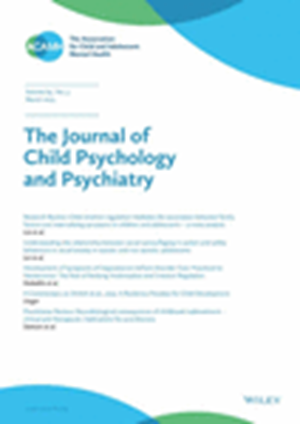Youth psychotic experiences: psychometric evaluation and diagnostic associations of the CAPE-16 in adolescents from the Norwegian Mother, Mather and Child Cohort.
IF 7
1区 医学
Q1 PSYCHIATRY
引用次数: 0
Abstract
BACKGROUND Adolescent self-reported psychotic experiences are associated with mental illness and could help guide prevention strategies. Youth report substantially more experiences than adults. However, with large societal changes like the digital revolution and COVID-19 pandemic, existing questionnaires may no longer accurately capture youth experiences. We aimed to determine the ability of the CAPE-16 questionnaire in capturing psychotic experiences across contexts (biological sex and COVID-19 response) and generations, thereby validating important psychometric aspects of the tool in modern adolescents. METHODS We used data from the Norwegian Mother, Father and Child Study (MoBa), a population-based pregnancy cohort. Adolescents responded to the CAPE-16 questionnaire (n = 18,835). For a comparison between age groups, we included adult men from the parent generation who responded to the CAPE-9 (n = 28,793). We investigated the psychometric properties of CAPE-16 through confirmatory factor analyses, measurement invariance testing across biological sex, response before/during the COVID-19 pandemic, and generations (adolescents and fathers), and examined subscale and item-level associations with subsequent registry-based psychiatric diagnoses (average time between CAPE and last registry update: 3.68 ± 1.34 years). RESULTS Out of 18,835 adolescents, 33.2% reported lifetime psychotic experiences. We confirmed a three-factor structure (paranoia, bizarre thoughts, and hallucinations) and good subscale reliability (ω = .86 and .90). CAPE-16 scores were stable across biological sex and pandemic status. CAPE-9 response patterns were non-invariant across adolescents and adult men, with an item related to digital technology particularly prone to bias. CAPE-16 subscales were associated with subsequent psychiatric diagnoses, especially psychotic disorders. CONCLUSIONS CAPE-16 is a reliable measure of psychotic experiences across sex and a major societal stressor in adolescents. More frequent and distressing experiences increase the risk of subsequent psychiatric diagnoses. Different response patterns between adults and adolescents for items related to digital technology suggest differences in interpretation. Hence, certain items may benefit from revisions.青少年精神病经历:来自挪威母亲、母亲和儿童队列的青少年CAPE-16的心理测量评估和诊断关联
青少年自我报告的精神病经历与精神疾病有关,可以帮助指导预防策略。青少年报告的经历比成年人多得多。然而,随着数字革命和COVID-19大流行等巨大的社会变化,现有的调查问卷可能不再准确地反映青年的经历。我们的目的是确定CAPE-16问卷在捕捉跨背景(生理性别和COVID-19反应)和代际精神病经历方面的能力,从而验证该工具在现代青少年中的重要心理测量学方面。方法:我们使用来自挪威母亲、父亲和儿童研究(MoBa)的数据,这是一个基于人群的妊娠队列。青少年回答了CAPE-16问卷(n = 18,835)。为了年龄组间的比较,我们纳入了对CAPE-9有反应的父母一代成年男性(n = 28,793)。我们通过验证性因子分析、跨生物性别、COVID-19大流行前/期间的反应和代际(青少年和父亲)的测量不变性检验来研究CAPE-16的心理测量特性,并检查亚量表和项目水平与随后基于登记的精神诊断的关联(CAPE与上次登记更新之间的平均时间:3.68±1.34年)。结果在18835名青少年中,33.2%的人报告终生精神病经历。我们证实了一个三因素结构(偏执,奇怪的想法,和幻觉)和良好的子量表可靠性(ω =。86和。90)。CAPE-16评分在生理性别和流行病状态上都是稳定的。CAPE-9的反应模式在青少年和成年男性中不是不变的,与数字技术相关的项目特别容易产生偏差。CAPE-16亚量表与随后的精神诊断,尤其是精神障碍相关。结论scape -16是一种可靠的跨性别精神病经历测量方法,也是青少年主要的社会压力源。更频繁和痛苦的经历增加了随后精神病诊断的风险。成年人和青少年对数字技术相关项目的不同反应模式表明在解释上存在差异。因此,某些项目可能会从修订中受益。
本文章由计算机程序翻译,如有差异,请以英文原文为准。
求助全文
约1分钟内获得全文
求助全文
来源期刊
CiteScore
13.80
自引率
5.30%
发文量
169
审稿时长
1 months
期刊介绍:
The Journal of Child Psychology and Psychiatry (JCPP) is a highly regarded international publication that focuses on the fields of child and adolescent psychology and psychiatry. It is recognized for publishing top-tier, clinically relevant research across various disciplines related to these areas. JCPP has a broad global readership and covers a diverse range of topics, including:
Epidemiology: Studies on the prevalence and distribution of mental health issues in children and adolescents.
Diagnosis: Research on the identification and classification of childhood disorders.
Treatments: Psychotherapeutic and psychopharmacological interventions for child and adolescent mental health.
Behavior and Cognition: Studies on the behavioral and cognitive aspects of childhood disorders.
Neuroscience and Neurobiology: Research on the neural and biological underpinnings of child mental health.
Genetics: Genetic factors contributing to the development of childhood disorders.
JCPP serves as a platform for integrating empirical research, clinical studies, and high-quality reviews from diverse perspectives, theoretical viewpoints, and disciplines. This interdisciplinary approach is a key feature of the journal, as it fosters a comprehensive understanding of child and adolescent mental health.
The Journal of Child Psychology and Psychiatry is published 12 times a year and is affiliated with the Association for Child and Adolescent Mental Health (ACAMH), which supports the journal's mission to advance knowledge and practice in the field of child and adolescent mental health.

 求助内容:
求助内容: 应助结果提醒方式:
应助结果提醒方式:


